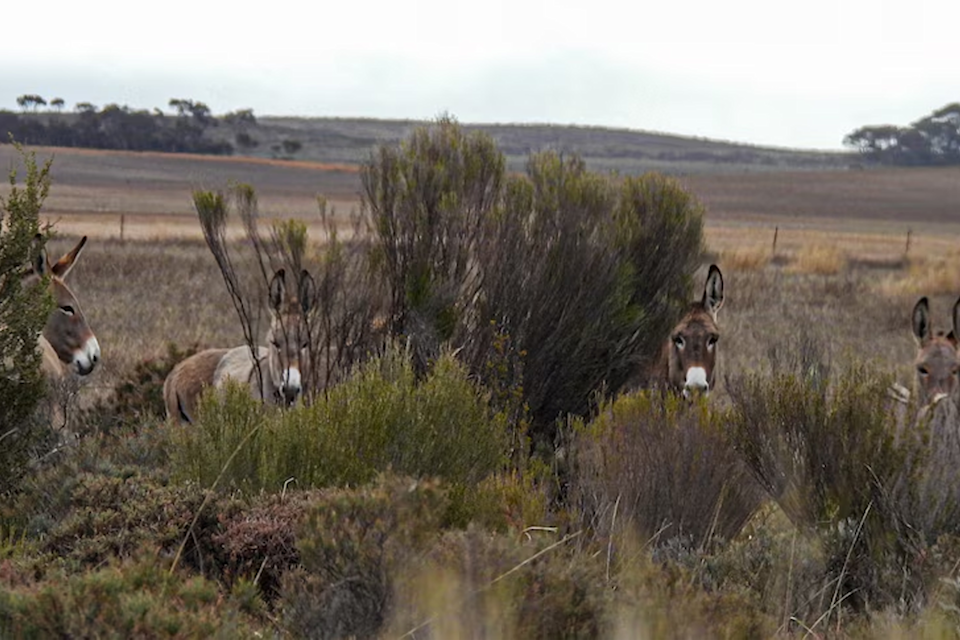For millions of years, Australia evolved in near-isolation, its unique ecosystems untouched by the threats posed by introduced species from overseas.
But, when Europeans arrived, that all changed. Now, we have one of the worst track records in the world when it comes to invasive pests, with everything from cane toads, foxes, feral pigs and deer running amok across unimaginably large parts of the country.
While some species generate a lot of attention, others often escape the spotlight. That’s mainly been the case for feral donkeys in Australia, despite there being between two to five million living in the country, according to the Centre for Invasive Species Solutions.
Feral donkeys were originally introduced in the 19th century for transport and work in remote areas, particularly in Western Australia and the Northern Territory, but after becoming redundant with mechanisation, many were released or escaped and have since established large populations.
This month, a herd was spotted in Victoria, much farther south than their usual range. Professor of Wildlife Ecology and Conservation at Deakin University, Euan Ritchie, said that while in this case, it’s more likely the group escaped from a nearby property rather than an “expansion into the area from feral populations”.
But, he warned it’s “concerning” whenever invasive animals are detected in regions where they don’t already occur. In an interview with Yahoo, he said it’s especially alarming “when it happens in conservation areas such as national parks”.
“Such incidents need to be acted on swiftly to ensure populations don’t become established and to minimise any environmental harm,” Ritchie warned.

A herd of donkeys was recently sighted in the Big Desert State Forest in Victoria’s northwest. Source: Big Desert Dingo Research
What damage do feral donkeys do to Australia’s environment?
Ritchie explained that feral donkeys can cause a range of issues, some potentially devastating to already fragile ecosystems.
Related: Couple ‘panicked’ by donkey discovery beside outback road
He said their impact includes overgrazing, which reduces plant cover and diversity while promoting the spread of woody, unpalatable species; the dispersal of weeds via their fur and droppings; soil compaction and erosion; the risk of transmitting parasites and diseases to other animals; and competition with native wildlife — such as kangaroos, wallaroos, and wallabies — for food and access to waterholes.
As a result of more open vegetation, it can make it easier for feral cats and foxes to hunt native wildlife, Ritchie added. “Further, Australia has over 1000 species of threatened plants, and grazing by introduced and feral herbivores, including donkeys, increases their risk of extinction,” he said.
To make matters worse, feral donkeys are “generalist and very hardy herbivores” and have the potential to invade most terrestrial ecosystems in the country. “Given that Australia’s ecosystems are already under severe pressure from a range of threats, we must do all we can to prevent any further new and compounding impacts, such as those posed by the spread and increased abundance of feral donkeys.”

It’s estimated there are some two million feral donkeys in Australia. Source: Getty
How can the public fight back?
Across the vast areas where feral donkeys are found, the most effective control methods include aerial and ground shooting, exclusion fencing, and — where terrain allows — localised trapping and mustering.
Another technique involves using “Judas donkeys” — sterilised donkeys fitted with tracking devices that are released to join wild herds, making it easier for authorities to locate and cull the rest of the group.
But, because they occur over “very large areas of arid and northern Australia, much of which is in very remote and rugged” country, this is difficult, with little to no road access to some regions.
“They also occur in very large numbers in some areas, meaning control efforts need to be substantial and sustained in order to meaningfully reduce their numbers and impacts,” Ritchie said.
He said this highlights the essential need for early intervention when it comes to invasive species.
“It’s far cheaper and easier to control a population of invasive animals before they become established, abundant, and widespread. Donkeys are no different in this respect. Intervening early also minimises any potential harm to the environment and agriculture,” Ritchie said.
In recent decades, it’s estimated that in excess of $80 million has been spent on donkey eradication efforts, with over 500,000 killed in the Kimberley Region of WA alone since the 1970s.
“All invasive species can potentially have significant impacts on Australia’s wildlife and ecosystems, and they can compound other threats,” Ritchie added.
In some areas, ecosystems might be affected by multiple invasive, large herbivores and omnivores, meaning the total grazing pressure on vegetation is unsustainable and can lead to biodiversity decline and extinction.
“In northern Australia, for example, some areas have feral donkeys, feral horses, feral cattle, feral water buffalo and feral pigs, all in the same area. In arid Australia, feral camels, feral donkeys, feral horses, feral cattle, feral goats and introduced European rabbits may all co-occur,” Ritchie said.
Love Australia’s weird and wonderful environment? 🐊🦘😳 Get our new newsletter showcasing the week’s best stories.


